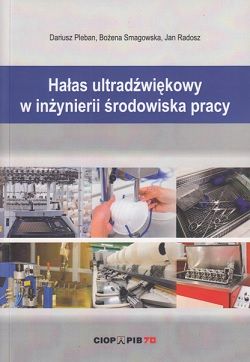
Authors: Dariusz Pleban, Bożena Smagowska, Jan Radosz, CIOP-PIB, Warsaw 2020, ISBN 978-83-7373-345-9
- Introduction (7)
- 1. Ultrasound - basic concepts (10)
- 2. The impact of ultrasonic noise on humans (17)
- 2.1.Introduction (17)
- 2.2.The influence of ultrasonic noise on the human hearing organ (20)
- 2.3.Thermal Effects of Ultrasonic Noise (23)
- 2.4.The impact of ultrasonic noise on functional changes in the human body (24)
- 2.5.Subjective symptoms resulting from exposure to ultrasonic noise (27)
- 3. Nuisance of ultrasonic noise (29)
- 3.1.Surveys concerning the nuisance of ultrasonic noise (29)
- 3.2.The nuisance of ultrasonic noise for humans carrying out specific tasks (31)
- 4. Criteria for assessing exposure to ultrasonic noise in the work environment (39)
- 4.1.Occupational exposure limit values to ultrasonic noise (39)
- 4.2.Exposure assessment and occupational risk assessment related to exposure to ultrasonic noise (44)
- 5. Measurements of ultrasonic noise in the work environment (49)
- 5.1.Methods of testing acoustic fields in the frequency range above 8 kHz (49)
- 5.2.Ultrasonic noise measurement method at workplaces (50)
- 6. Industrial sources of ultrasonic noise (56)
- 6.1.Classification of industrial sources of ultrasonic noise (56)
- 6.2.Industrial Technological Sources of Ultrasonic Noise (57)
- 6.3.Industrial non-technological sources of ultrasonic noise 57
- 6.4.Exposure to ultrasonic noise at workplaces (60)
- 7. Reduction of hazards caused by ultrasonic noise (76)
- 7.1.Ways to reduce occupational exposure to ultrasonic noise (76)
- 7.2.Sound absorption by materials in the frequency range above 5 kHz (81)
- 7.3.Acoustic insulation of partitions in the frequency range above 5 kHz (85)
- 7.4.Hearing protectors (89)
- Bibliography (95)
- Regulations and standards (101)
- Annex: Catalog concerning acoustic insulation of selected partitions in the frequency range from 5 to 25 kHz (105)






